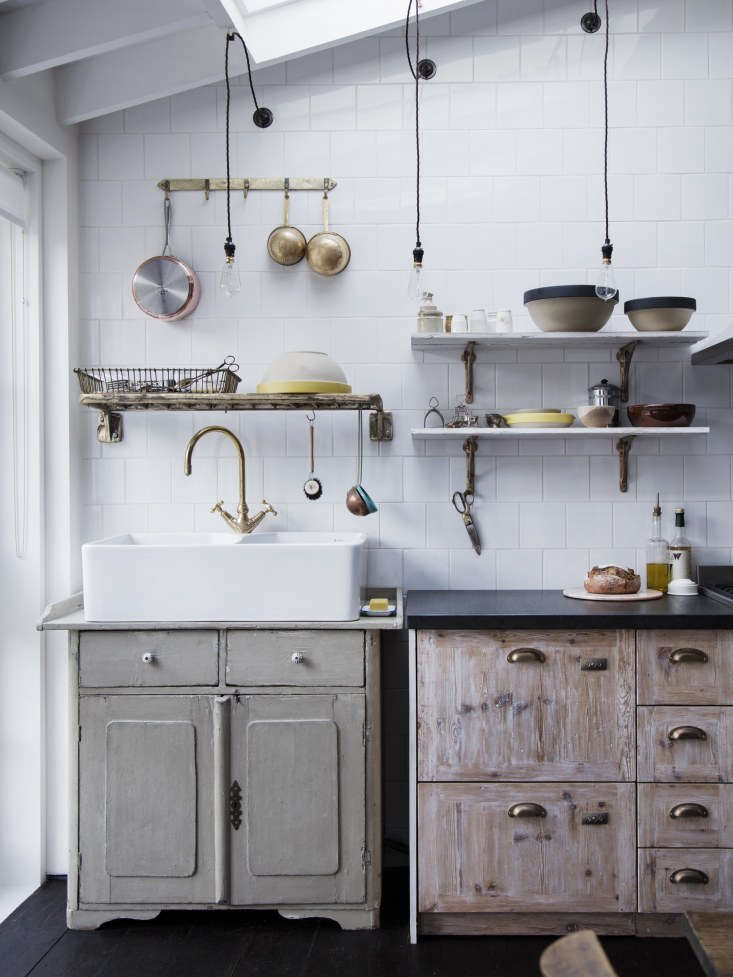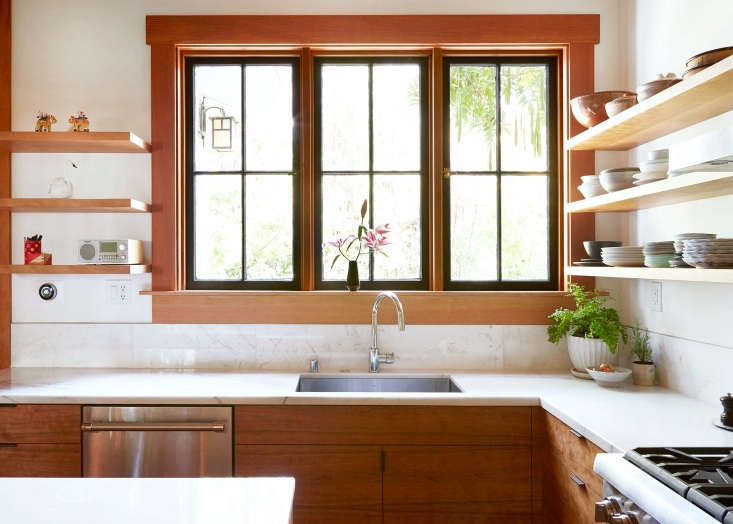Sink size is a personal choice. If you know your way around a kitchen, and especially if you’ve worked with different-sized sinks over the years, you probably know what you like. But if you’re starting out, we’re here to help.
Architect Jerome Buttrick of Buttrick Projects Architecture & Design, a member of the Remodelista Architect and Designer Directory, is based in Oakland, California, and has plenty of experience (he’s been practicing for more than 25 years and worked on not one but four renovations with Remodelista founder and editor Julie Carlson). And, for an appliance perspective, we also checked in with Reece Williams, who’s handled sales for 20 years at Cherin’s Appliance in San Francisco, in business since 1892.
Note that we’re only considering sink sizes here; in a later post in this series, we’ll look at the pros and cons of single-bowl versus double-bowl sinks. Also, the words used to describe sink dimensions can be confusing (for example, for a contractor, the “depth” of a sink is the distance from front to back, not the depth of the bowl). For our purposes, in this post we’ll refer to sink length (how far a sink extends along the countertop), width (the distance from front to back), and depth (how deep the bowl is).

Is there a standard sink size for the kitchen?
Both Buttrick and Williams say they’re seeing many more single-bowl sinks installed than double-bowl. According to Williams of Cherin’s Appliances, customers typically choose a single-bowl dimension of about 28 to 30 inches long, and “they’re quite happy with that—it gives them enough room to do two things in the sink at once.”
Buttrick recommends a sink that is at least 27 inches long, 19 inches wide, and 7.25 inches deep. “Once you factor in the three-quarter-inch counter depth, the sink is eight inches deep,” he says. Similar-size models are also available commercially.

How do I know what size sink I need?
A commercially made single-bowl sink can be as long as 33 inches, while a double-bowl model can reach 48 inches. Either of those takes up a lot of kitchen real estate, so your decision may well be based on how much counter space you can spare. Budget might also help you choose—but in any remodel, sink cost is far from the biggest slice.
Most people who cook prefer a sink that’s larger rather than smaller: You don’t often hear someone complain their sink is “too big.” An undersized sink quickly gets crowded and cluttered, and it’s hard to wash large pots, pans, and woks; extra space is better for both food prep and cleanup. But once your sink is above a certain size, advises Buttrick, you should have a spray head or gooseneck faucet you can use to flush food particles toward the drain.
Note that extras such as integrated drain boards (like the one above) will eat up more room. Another consideration: It’s helpful to reserve some counter space on both sides of the sink for stacking unwashed and clean items.

What should I know about installation methods?
Most kitchen sinks are installed in one of three ways:
A drop-in sink fits into a cutout in the countertop, with the rim resting on the counter.
An undermount sink is installed under the countertop.
An apron-front sink, which is generally longer and deeper than average, is installed so that the front, or “apron,” is exposed for a cottage-y look.
Obviously, if you’re replacing an old sink but not the countertop, you need to make sure the cutout will accommodate the new sink. If the cabinet allows, you may be able to size up the sink by expanding the cutout. Same countertop, smaller sink? Not advised.
Many people shopping for a new sink are undergoing a full kitchen renovation, and in those cases, as Williams points out, “A new countertop offers a good opportunity to make improvements. A customer who has an old drop-in sink, with a rim that collects gunk, on top of an old tile countertop, is thrilled to replace those with a new solid-surface counter and an undermounted sink.” And a bigger sink, if you have room to spare, may be a smart upgrade as well.

What are the pros and cons of a deeper sink?
A number of sinks on the market are two to three inches deeper than the usual eight inches. Depending on the sink’s width and length, the extra depth can make it easier to wash oversize pots—which is especially useful for anyone cooking for a big family or a large numbers of guests. (Think of that roasting pan for the holiday turkey.) Another plus: If your sink is visible from the dining table, it’s easier to hide the dirty pots and dishes.
The drawback is in the ergonomics. “We often have discussions with clients about the benefits of a deeper sink,” says Buttrick. “That discussion ends when people understand it can be a back-breaker.” By his calculations, someone who’s six feet tall already has to bend over six or seven inches to reach the sink bottom—“so making the sink two inches deeper can really get to you.”
For shorter people, however, the extra depth is less of a problem. “If you’re five foot three, a ten-inch-deep sink will be easier on you,” says Buttrick.

What size sink works best in a small kitchen?
When counter space is at a premium, you’re likely to go for a smaller sink. But many homeowners (including myself) find that a 22-inch-long sink will serve most purposes. (Have a really tiny kitchen? New Zealand-based designer Karin Montgomery Spath installs 9-by-15-inch sinks in her kitchenettes; see Expert Advice: The New Kitchenette: 11 Tips for an Efficient Small Kitchen for more.)
Still, it’s wise not to skimp on size if at all possible. If your tiny kitchen doesn’t allow for a dishwasher, a roomy sink matters even more for hand-washing. It’s also good if you’re the clean-as-you-go type. Some ingenuity might be needed to create more counter space, such as an integrated cutting board that sits over the sink.

Is a bar sink too small to be useful?
Not at all, says Buttrick. “A separate bar sink is great when you have two people who are active participants in the kitchen. You can use it not just for making drinks, but for, say, vegetable prep or fixing a vase of flowers.” He generally specifies a 12-inch stainless sink for that purpose. Note that installing a second sink in a different location than the main sink will incur extra plumbing fees.
On the other hand, Williams finds that most San Francisco kitchens can’t accommodate a second sink, however small. “It’s not that our customers don’t want it,” he says, “but they really don’t have room for it.” As with most renovation decisions, consider your lifestyle to help determine what size sink is right for you: How big are your most-used pans? How often do you entertain? Would you rather have extra counter space or a bigger sink?
To help decode more remodeling decisions in the kitchen, see our posts:
- Remodeling 101: A Primer on Kitchen Countertops
- Remodeling 101: What to Know When Replacing Your Range
- Remodeling 101: What to Know When Replacing Your Dishwasher
Featured photograph by Belathée Photography and courtesy of H2 Design + Build, from Kitchen of the Week: A Before & After Office Rental in Seattle.
Finally, get more ideas on how to evaluate and choose your kitchen sink and faucet in our Remodeling 101 Guide: Kitchen Sinks & Faucets.
Frequently asked questions
What factors should I consider when choosing the size of a kitchen sink?
When choosing the size of a kitchen sink, consider the available space in your kitchen, your cooking and cleaning habits, the size of your countertops, and the size of your cabinets. It's important to find a sink that fits well within your kitchen layout and meets your specific needs.
How do I measure for a kitchen sink?
To measure for a kitchen sink, start by measuring the width and depth of the base cabinet where the sink will be installed. Take into account any modifications or accessories, such as a garbage disposal. Additionally, consider the desired sink style, such as top mount or undermount, to ensure proper fit and installation.
What is the standard size for a kitchen sink?
The standard size for a kitchen sink can vary, but a typical size for a single-bowl sink is around 30 to 33 inches in width and 20 to 22 inches in depth. Double-bowl sinks can range from 30 to 48 inches in width, depending on the bowl size and configuration.
Can I install a larger sink in a small kitchen?
It is possible to install a larger sink in a small kitchen, but it's important to consider the available countertop space and cabinet size. Be mindful of the proportion and functionality of the sink within the overall kitchen layout.
Can I install an oversized or farmhouse sink in any kitchen?
Oversized or farmhouse sinks can be installed in kitchens, but they require careful planning and consideration of the cabinet and countertop support. These sinks typically have unique installation requirements and may require custom modifications to accommodate their size and weight.
How deep should a kitchen sink be?
The depth of a kitchen sink depends on personal preference and needs. Standard sink depths range from 8 to 10 inches, but deeper sinks, such as 10 to 12 inches, can provide more capacity for large pots and pans. Consider the size of your cookware and the tasks you typically perform in the sink when choosing the depth.
Should I choose a single-bowl or double-bowl sink?
The choice between a single-bowl or double-bowl sink depends on personal preference and the way you use your kitchen. Single-bowl sinks offer more space for larger items and are easier to clean, while double-bowl sinks provide separate areas for multitasking and food preparation.
Can I install an undermount sink with any type of countertop?
Undermount sinks can be installed with various types of countertops, including natural stone, quartz, and solid surface materials. However, it's important to consult with your countertop supplier or installer to ensure that the chosen sink and countertop are compatible for a secure and proper installation.
What materials are available for kitchen sinks?
Kitchen sinks are available in a variety of materials, including stainless steel, cast iron, composite granite, fireclay, and porcelain. Each material has its own characteristics in terms of durability, aesthetics, and maintenance requirements. Consider your preferences and lifestyle when choosing the material for your sink.
Should I consult a professional for kitchen sink selection and installation?
Consulting a professional, such as a kitchen designer or plumber, can be beneficial when selecting and installing a kitchen sink. They can provide guidance on the right size, material, and installation method based on your specific needs and kitchen layout.




Have a Question or Comment About This Post?
Join the conversation